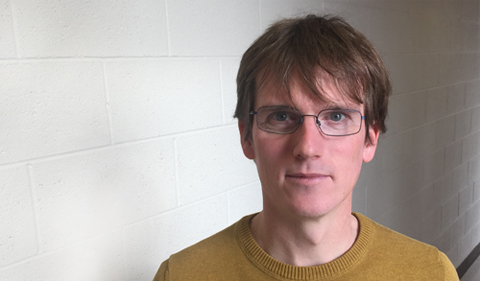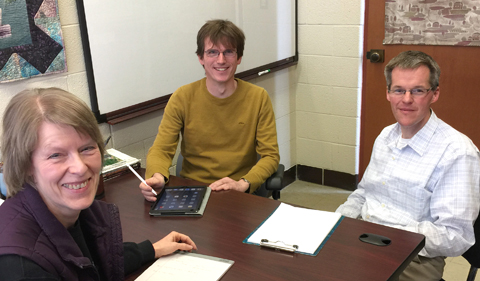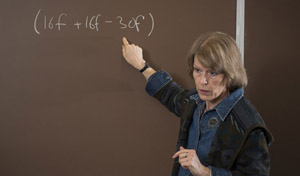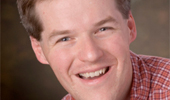
Dr. Andreas Nogga
By Jamison Lahman, PACE writer and Jean Andrews
Physics & Astronomy
Ohio University’s 2016-17 Visiting Glidden Professor Dr. Andreas Nogga seeks to understand more about the forces holding atomic nuclei together. As one of the leading few-body theoretical physicists, he studies the strong nuclear force, one of the four fundamental forces of nature.
Research on few-body problems involves studying systems at varying distance scales, from sub-atomic particles like protons and neutrons, through nuclei, all the way up to molecules and clusters of atoms.
Nogga serves as a staff scientist at the Institute for Advanced Simulation and the Institute for Nuclear Physics at the Jülich Research Center, Germany, or IKP JÜLICH, one of the world’s leading nuclear physics research institutes.
Nogga is spending the academic year in Athens working with Dr. Charlotte Elster, Professor of Physics & Astronomy and member of OHIO’s Institute of Nuclear and Particle Physics, or INPP. Together they are working on formulating the equations that describe the interaction of nucleons, the proton and neutron, within the nucleus of an atom. They hope that new insights about these interactions will lead to an understanding of the processes governing nuclear reactions.
At the heart of Nogga’s current research is trying to understand the forces between all the nucleons in the nucleus and solving quantum-mechanical equations that govern the system to determine its structure. The solution of these very complex equations has become possible in recent years because of the advent of massive computing power.
While at OHIO, Nogga shares his experience in nuclear and computational science at meetings, workshops, and seminars with students and faculty in the departments of Physics & Astronomy, Mathematics, and the Russ College of Engineering and Computer Science.
“The strong interaction is the most amazing part of what physicists call the Standard Model of Particle Physics,” Nogga says. “Our quest is still to answer, ‘What are the interactions that bind nuclei together?’ It is what is generating the mass of what surrounds us every day. This is not well understood and yet it drives our universe.”
Contemporary nuclear physics seeks to understand how the huge variety of nuclei in our cosmos emerge from the force that acts between nucleons and solve the quantum-mechanical equations that govern the system to determine its structure.
Such calculations are particularly important for our understanding of nuclei with extreme neutron-to-proton ratios. These nuclei can have lifetimes of only a fraction of a second, but are formed—and play a key role in—extreme stellar environments like supernovae. They exhibit a structure that is very different from that of the “usual” stable nuclei, nuclei that have roughly the same number of neutrons and protons. Instead of being a clump of nucleons, extreme nuclei tend to have rather exotic structures, for example, a dense core surrounded by a “halo” of neutrons. Very little is known about such exotic structures experimentally, since such nuclei are difficult to make in the laboratory.
Few-Body Physics Research at Ohio University

Dr. Nogga meets with Drs. Elster and Phillips
While at OHIO, Nogga is collaborating with other few-body physics researchers, headed by Elster and Dr. Daniel Phillips, a theoretical physicist in the department and current INPP Director. The team includes OHIO Post-Doctoral Researcher Dr. Lei Jin, and Dr. Linda Hlophe. Hlophe is Elster’s former student and a post-doctoral researcher at Michigan State University.
“Dr. Nogga’s status as a leader in nuclear physics research is attested to by the myriad citations of his papers, his key role in international collaborations and the international nuclear-theory community, and his position at the IKP in Jülich, Germany,” says Phillips. “While visiting OHIO for the year, Nogga’s expertise overlaps excellently with research being undertaken by both INPP theorists and INPP experimentalists. His stay in Athens will facilitate collaboration with INPP faculty on these topics. It will also benefit our students and other students in associated fields of study, as Dr. Nogga shares his deep understanding of the forefront computational methods and architectures which he uses to perform his calculations.”
When asked about the significance of his research while at OHIO, Nogga believes the implications for basic science, such as understanding nucleon interactions, are typically hard to predict. Rather than research related to developing nuclear reactor development, for example, his studies are likely to help scientists understand the processes of stars where exotic nuclei exist, but decay quickly.
“It has been very instructive for me to be here,” Nogga says. “I’m thankful that the support of many different sources made it possible that I can be here for an extended period of time.”
The Robert and René Glidden Visiting Professorship
The Robert and René Glidden Visiting Professorship program supports short-term academic appointments for distinguished visitors to Ohio University. The purpose of the professorship is to expose Ohio University students and faculty to outstanding individuals, and make such individuals aware of the strengths and resources of Ohio University. Glidden Professors are expected to be distinguished individuals who have attained wide recognition based upon their artistic, engineering, historical, literary, or scientific achievement.
Nogga’s award totaling $26,000 came from a variety of sources. In addition to the $10,000 received from the Robert and René Glidden Visiting Professorship program, he received support from INPP, the Department of Physics & Astronomy, the Russ College of Engineering and Technology, and the U.S. Department of Energy.
Dr. Charlotte Elster contributed to this article.
Visit Nogga’s German webpage



















Comments